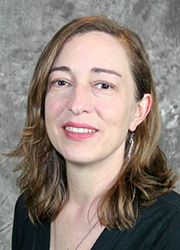
2002-2008 PhD (chemistry) UW-Madison under Laura L. Kiessling
2009-2013 Postdoc (chromatin biology) Stanford University under Gerald R. Crabtree
Currently Accepting Students
See our website for more information: www.dykhuizenlab.com
Recent genome sequencing studies and CRISPR-based screening have uncovered frequent mutations and dependecies on epigenetic regulators in cancer. We are interested in using a combination of chemical and biochemical techniques to uncover the role of chromatin structure in cancer development and progression. Uncovering the mechanisms of these complexes will reveal potential therapeutic avenues for cancers that currently have few therapeutic options. Three areas of research we are currently pursuing are:
1- Elucidating the function and genome-wide targeting of subunits of chromatin remodeling complexes that contain chromatin binding domains, such as bromodomains, PHD domains and chromodomains. We wish to understand how the targeting domains found in subunits of chromatin remodeling complexes contribute to their biological function, particularly in facilitating cell fate transitions during cancer progression and therapy resistance. We identify histone modifications bound by these domains and to relate this information to genome wide studies of histone marks and chromatin regulation during cancer progression. Through these studies we hope to identify if the deletion or inhibition of specific subunits of chromatin remodelers in cancer leads to changes in targeting across the genome and a subsequent alteration in the transcription of known oncogenes or tumor suppressors.
2-High throughput screening and development of inhibitors of chromatin regulators. We are interested in developing inhibitors of chromatin-binding domains important in the progression and chemoresistance of cancer.
3-Proteomic analysis of chromatin modifying complexes. While different subunits of the SWI/SNF chromatin remodeling complexes are mutated in approximately 20% of human malignancies, in any particular cancer the mutations are often found only in one particular subunit. Cell type specific expression of homologous subunits or interaction with cell type specific factors may explain this phenomenon. We use mass spec to analyze the complex subunits and associated factors in cancer to define cancer-specific SWI/SNF and polcomb repressive complexes (PRC).
Alisha Dhiman (Post-Doctoral Research Associate)
Jiao Guanming (Graduate Student)
Sandra Carolina Ordonez Rubiano (Graduate Student)
Jude Tetteh Quarshie (Graduate Student)
Rinky (Post-Doctoral Research Associate)
Surbhi Sood (Graduate Student)
Brayden Paul Strohmier (Graduate Student)
Shelley L. Woloshuk (Lab Manager)
https://pubmed.ncbi.nlm.nih.gov/?term=dykhuizen+e

